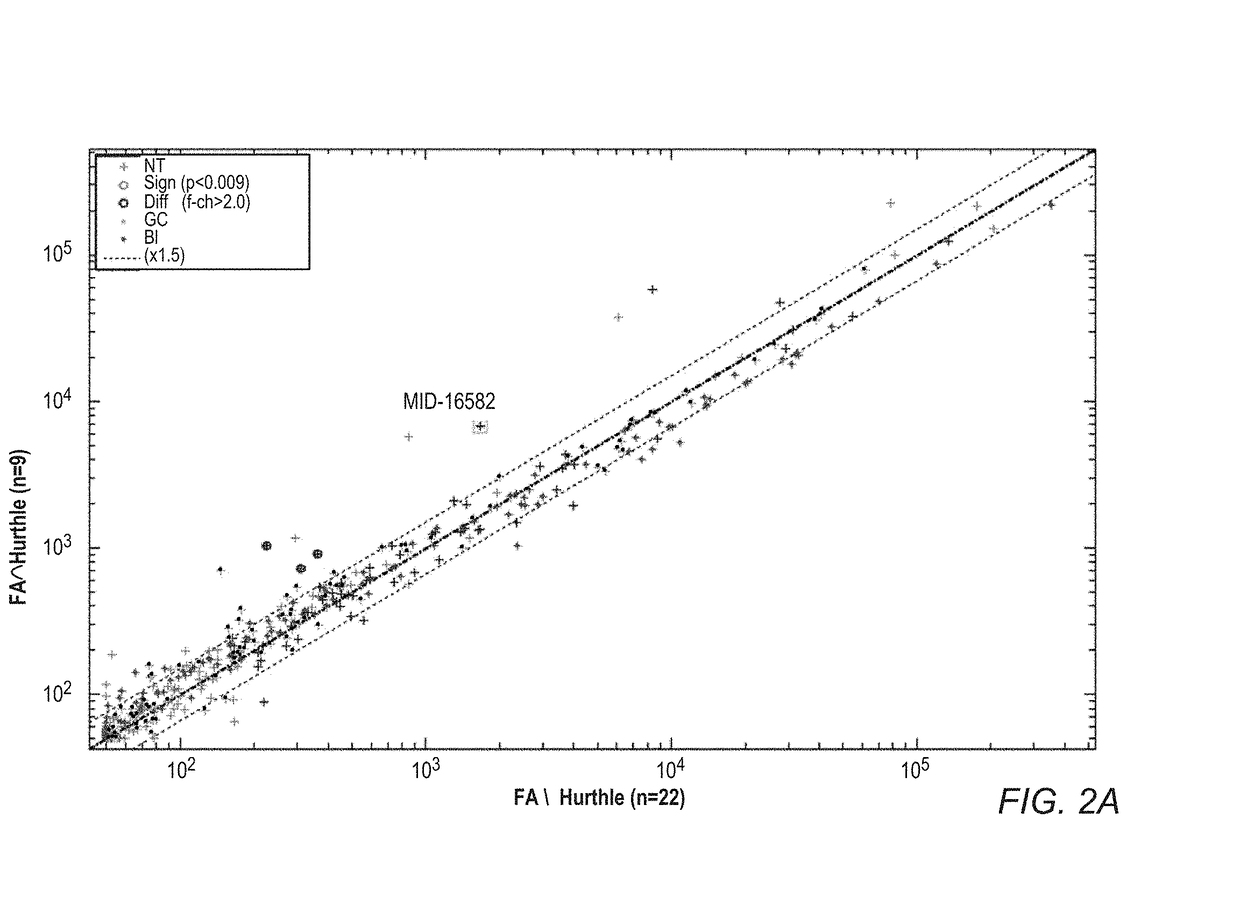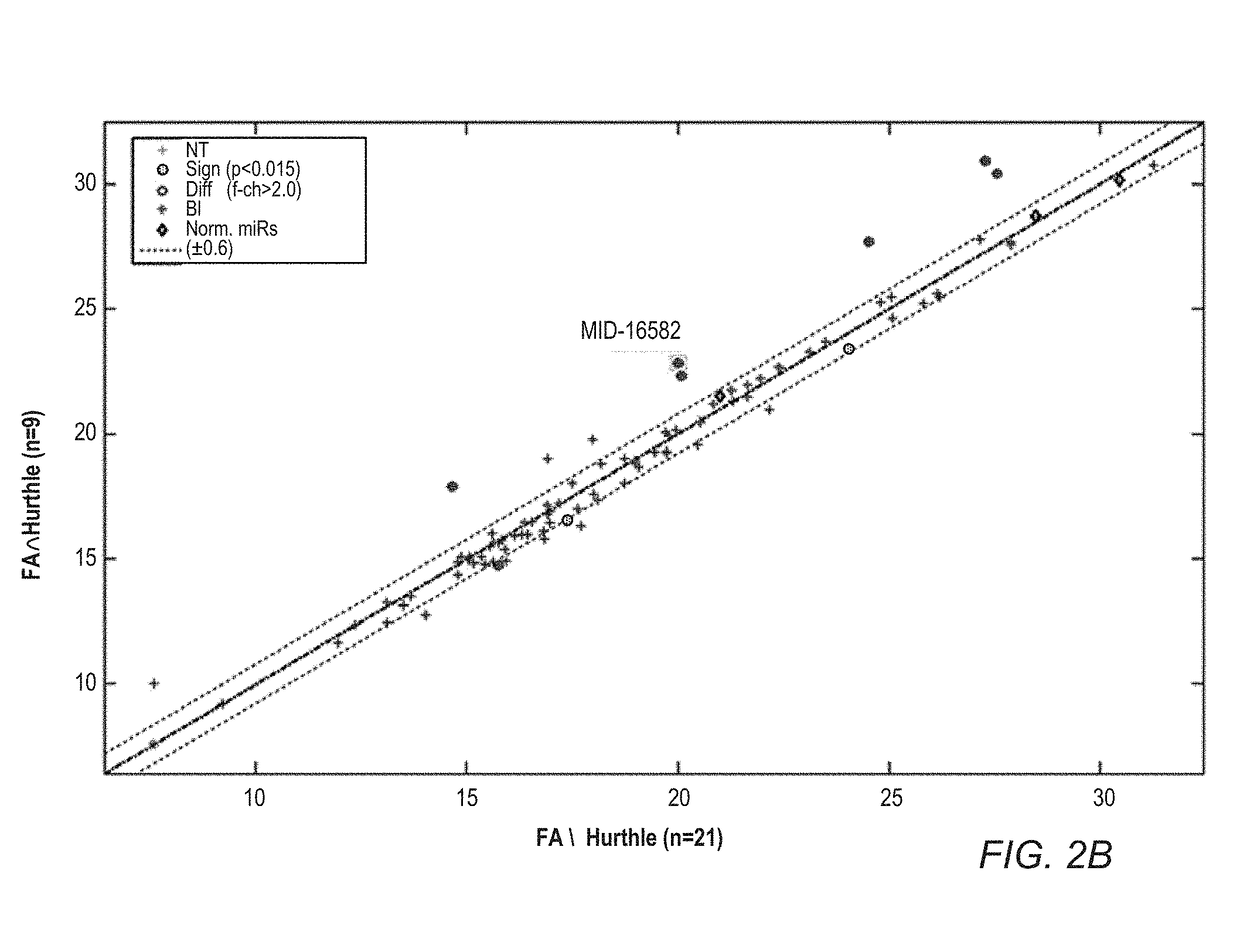Mirna expression signature in the classification of thyroid tumors
a thyroid tumor and expression signature technology, applied in the field of thyroid tumor classification methods, can solve the problems of rapid or irregular heartbeat, nervousness, weight loss, and feeling of being too warm
- Summary
- Abstract
- Description
- Claims
- Application Information
AI Technical Summary
Benefits of technology
Problems solved by technology
Method used
Image
Examples
example 1
of microRNA in Pre-Operative Samples
[0292]A pilot study of microRNA profiling was conducted in a few Papanicolaou, Giemsa and Diff-Quick stained smears from ex-vivo FNA biopsy samples in order to ensure feasibility of the methodology. Since FNA smears often have very few cells, providing a minuscule amount of RNA for analysis, e.g. 1-1000 ng, it was first necessary to evaluate whether microRNA would be detectable under such low RNA amounts. Thus, microRNA expression levels of about 2200 individual microRNAs was measured in Giemsa-stained papillary carcinoma and non-papillary carcinoma smears. Five microRNAs (hsa-miR-146b-5p, hsa-miR-31-5p, hsa-miR-222-3p, hsa-miR-221-3p, and hsa-miR-21-5p), previously shown to correlate with papillary carcinoma were found over-represented (upregulated) in the papillary-carcinoma smears. A comparison of microRNA expression between Giemsa-stained papillary carcinoma and non-papillary carcinoma samples, revealed the highly up-regulated microRNA markers...
example 2
ial microRNA Expression Between Malignant and Benign Thyroid Lesions
[0293]The cohort of samples used in the experimental analysis is shown in Table 7 as cohort II. The histological diagnosis assessed ultimately the malignancy or benignity of the thyroid lesions. The cytological classification was based on “The Bethesda System for Reporting Thyroid Cytopathology” (Syed, Z. Ali and Edmund S. Cibas, eds.; DOI 10.1007 / 978-0-387-87666-5_1; Springer Science+Business Media, LLC 2010). The study protocol was approved by the Institutional Review Board (IRB, equivalent to Ethical Review Board) of the contributing institution. Tumor classification was based on the World Health Organization (WHO) guidelines. An additional cohort consisted of 13 thyroid ex-vivo FNA smears, prepared after thyroidectomy, and obtained from the University Milano-Bicocca (Milan, Italy).
[0294]Total RNA (at least 10 ng) was extracted from these samples, and microRNA expression was profiled using custom microarrays cont...
example 3
shing Different Sub-Types of Malignant and Benign Thyroid Lesions
[0296]Expression levels of miRs were compared in 18 follicular adenoma samples and 10 follicular carcinoma samples. microRNAs that were upregulated or downregulated in follicular adenoma relative to follicular carcinoma are presented in Table 4.
TABLE 4miRNAs up- or downregulated in follicular adenoma versus follicularcarcinomaMedianfold-FollicularFollicularmiR namep-valuechangeAUCadenomacarcinomahsa-miR-486-3p2.80E−022.04 (+)0.774.80E+022.40E+02MID-011415.50E−021.91 (+)0.733.50E+021.80E+02hsa-miR-193a-3p2.70E−021.45 (+)0.763.10E+022.20E+02hsa-miR-148b-3p3.90E−021.25 (−)0.714.50E+025.60E+02p-values were calculated using a two-sided (unpaired) Student's t-test.The fold-change represents the ratio between the median values of each group.AUC: Area under the curve when using the miRNAs to classify the two groups.Median: median of expression values (rounded).
[0297]Expression levels of miRs were compared in 18 follicular aden...
PUM
 Login to View More
Login to View More Abstract
Description
Claims
Application Information
 Login to View More
Login to View More - R&D
- Intellectual Property
- Life Sciences
- Materials
- Tech Scout
- Unparalleled Data Quality
- Higher Quality Content
- 60% Fewer Hallucinations
Browse by: Latest US Patents, China's latest patents, Technical Efficacy Thesaurus, Application Domain, Technology Topic, Popular Technical Reports.
© 2025 PatSnap. All rights reserved.Legal|Privacy policy|Modern Slavery Act Transparency Statement|Sitemap|About US| Contact US: help@patsnap.com



